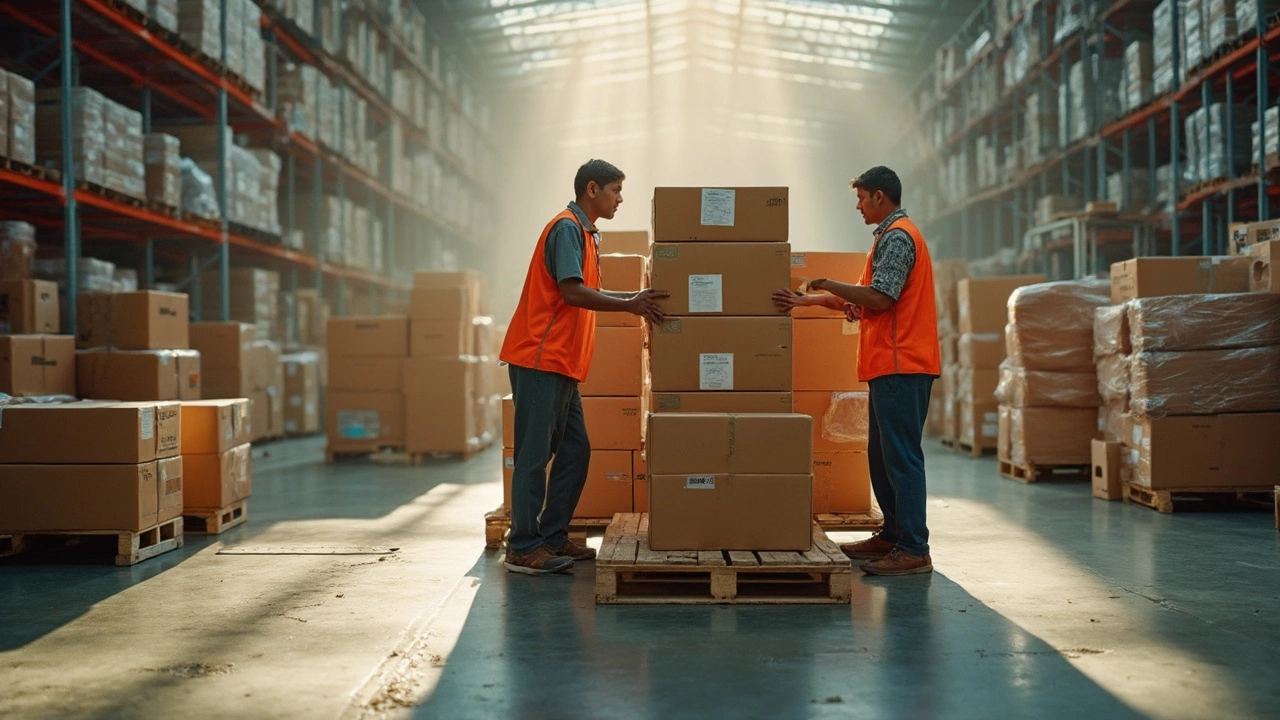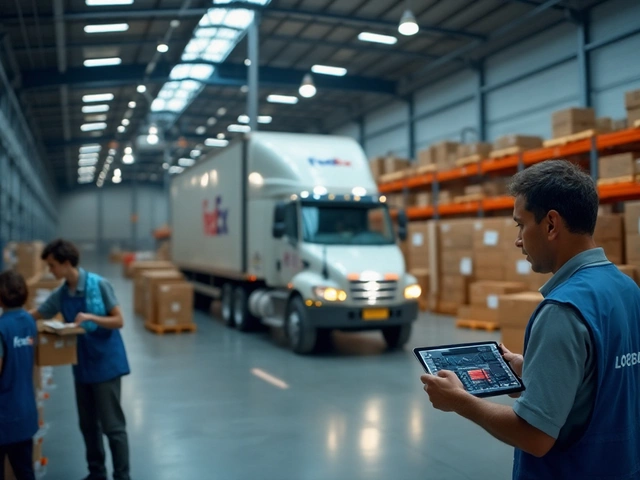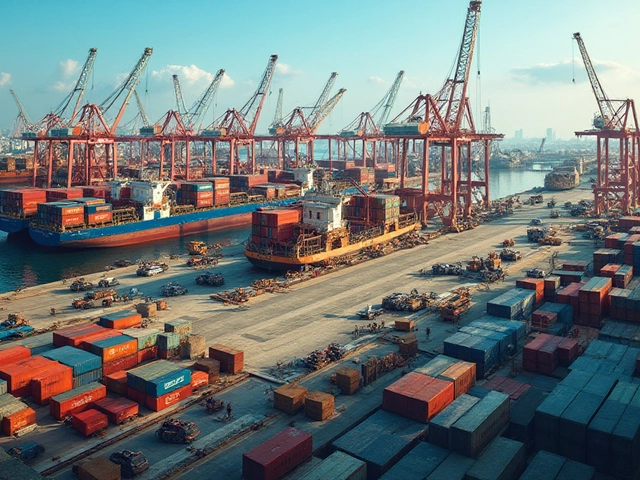Trying to send a pallet order to Amazon isn’t just about stacking boxes and calling it a day. Amazon has a checklist for pallets that’s about as specific as a recipe for lasagna—and skipping a step can get your shipment rejected.
First, the basics: Amazon only accepts standard 40” x 48” wooden pallets for most deliveries. If you drop off anything weirdly sized or made from plastic, be prepared for a headache. The wood needs to be sturdy and free from damage or weird stains—no broken boards, exposed nails, or mystery smells. And don’t forget, pallets shipping overseas must be heat-treated and stamped “HT,” or customs will turn them right back around.
Amazon expects boxes to be stacked flat (not leaning like a game of Jenga) and shrink-wrapped tight enough that nothing slides off during a bumpy truck ride. And yeah, skip the temptation to pile your stuff as high as possible—Amazon won’t accept anything over 72 inches from the ground to the top of your shrink wrap.
- Why Amazon Has Strict Pallet Rules
- Standard Pallet Sizes and Materials
- How to Stack and Wrap Your Goods
- Labeling and Documentation Musts
- What to Expect During Delivery
- Quick Tips to Prevent Shipping Headaches
Why Amazon Has Strict Pallet Rules
The whole point of Amazon’s super-specific Amazon pallet delivery requirements is to keep things moving fast and smooth at their warehouses. Their business runs on speed—every package, pallet, and shipment gets scanned, moved, and stored by either a human or a robot. If a pallet turns up too big, too small, or messy, it slows down the whole line. Worst case, your entire delivery might get rejected or delayed, costing you time and money.
Think about it: Amazon receives thousands of pallet deliveries every single day. They want every single one to fit neatly onto their warehouse racks without anyone having to stop and move things around. If pallets are damaged, stacked too high, or weigh too much, workers can’t use forklifts safely. That’s why there are rules around weight—pallets can’t go over 1,500 lbs, and if they do, Amazon might make you break them down and re-deliver.
Amazon also has to meet certain legal and safety codes, especially at facilities that use a lot of automated equipment. If you send in pallets that aren’t heat-treated or have exposed nails, you risk contaminating goods or damaging expensive robots. Stuff like that can push back delivery schedules for everyone, not just your shipment.
Here’s a quick look at how strict pallet rules help Amazon keep things humming:
- Standard pallet sizes fit conveyor belts and racking systems perfectly.
- Sturdy, clean pallets avoid injuries to workers and prevent product damage.
- Shrink-wrap and stacking limits help avoid spills and accidents on the warehouse floor.
- Consistent labeling helps Amazon’s scanners and teams process deliveries lightning fast.
Bottom line, these rules aren’t just about being picky—they’re about making sure your products land in Amazon’s hands quickly and safely, ready for the next Prime delivery order.
Standard Pallet Sizes and Materials
Anyone sending shipments through Amazon pallet delivery has to know the pallet standards—Amazon is really strict about them. For almost all deliveries into Amazon Fulfillment Centers in the U.S., the standard pallet size must be 40 inches wide by 48 inches long. This isn't just a suggestion; anything bigger or smaller can cause a flat-out rejection or extra charges. That single size helps Amazon keep its warehouses running like clockwork.
Wood might seem old school, but it's all Amazon wants. They won’t accept plastic, metal, pressboard, or ultra-cheap pallets. Only wood—preferably hardwood like oak or softwood like pine—because it’s durable and able to handle the bumps of shipping. Every pallet must be solid, with no broken slats or sticking-out nails. If they spot a busted pallet on arrival, your entire shipment can get held up—or refused.
- Pallets must be four-way entry (a forklift or pallet jack can get in from any side).
- Stringers and bottom deck boards can’t be missing or cracked.
- All pallets shipping internationally must be heat-treated and show the “HT” stamp, which means they pass inspection and keep out pests. Amazon is serious about this.
- Maximum pallet weight is 1,500 lbs, including the pallet, but Amazon recommends not going over 1,000 lbs for safety and easier handling inside their warehouse.
Don’t go fancy with colored pallets, either—many dye pigments can rub off on goods or mess up warehouse equipment, so stick to natural wood. Amazon also warns against pallets treated with chemicals like methyl bromide (marked as “MB”) because they’re not safe for workers or products. Always double-check your pallets are marked “HT” instead of “MB.”
| Pallet Specification | Amazon’s Requirement |
|---|---|
| Size | 40" x 48" (1016 mm x 1219 mm) |
| Material | Wood (heat-treated if international) |
| Entry Type | Four-way entry |
| Weight limit | 1,500 lbs (recommended less than 1,000 lbs) |
Bottom line: double-check your pallet requirements before shipping. Making small mistakes can be expensive—not only in Amazon fines, but also lost time and goods stuck in limbo.
How to Stack and Wrap Your Goods
Getting the stacking and wrapping part wrong is where a lot of Amazon shipments go south. If you want to avoid headaches, here’s what matters when you’re prepping a Amazon pallet delivery for their warehouses.
Start by stacking your boxes flat and level. Always put the heaviest boxes on the bottom so things don’t turn into a leaning tower by the time your pallet arrives. If your cartons aren’t all the same shape, organize them Tetris-style so you fill gaps and keep the load stable. No boxes should hang over the edges; Amazon wants the shipment to be flush with the pallet’s footprint — 40” x 48”. Keeping edges neat stops boxes from getting crushed or snagged during loading.
- Never stack your pallet higher than 72 inches, including the pallet itself. Anything taller gets rejected at the dock.
- For best results, don’t mix FBA and non-FBA goods on a pallet. If you do, label each clearly, but really, just keep them separate.
- Boxes need to be sealed tight, so double-check that tape and seals won’t pop open mid-journey.
After stacking, you’ll want to use heavy-duty stretch wrap. Wrap from the bottom (covering about 2 inches of the pallet base) and work your way up, going around at least 3 times for a firm hold. Be sure the wrap sticks tight and pulls the whole load together. If your shipment’s valuable or top-heavy, consider a second person for extra stability or add corner boards to keep everything in place.
Strapping can add another layer of security. Some shippers use plastic or metal straps in addition to shrink wrap. Just be careful: don’t go overboard and crush your boxes.
| Key Pallet Wrapping Pointers | Amazon Requirement? |
|---|---|
| Max Pallet Height (including pallet) | 72 inches |
| Wrap coverage at pallet base | 2 inches minimum |
| Minimum wrap rotations | 3 full turns |
| Box overhang allowed | None |
If you’re cutting costs on wrap, don’t. Thin wrap tears, and you could end up with scattered boxes or refused delivery. And a pro tip: label all sides of the pallet so warehouse folks don’t have to spin it around like a pizza pie during unloading.

Labeling and Documentation Musts
If you want your Amazon pallet delivery to glide through check-in without a hitch, labels and documents are a big deal. Get this part wrong, and your shipment could end up sitting on the sidelines or even sent home.
Every pallet heading to Amazon needs a unique shipment ID label. You get these from Amazon’s shipment creation workflow in Seller Central or Vendor Central. These labels must be:
- Printed from a laser printer (no inkjet—Amazon scanners hate faded barcodes)
- Placed on all four sides of the pallet, about chest height for easy scanning
- Clear of any shrink wrap—apply the label after wrapping, not before
On top of that, every carton on the pallet needs its own barcode—usually an FNSKU (for sellers) or an Amazon product code. Slap these on before you pack the boxes. Don't mix products in a single carton, or Amazon's folks will stop the whole process to sort things out by hand.
If your freight shipping is headed to a Fulfillment Center (FBA), you also need a Bill of Lading (BOL). This is basically a short form listing what’s in the shipment, the number of pallets, and all IDs. Make sure the carrier brings two copies to delivery—Amazon keeps one, you keep one. Quick detail: Pallets without a BOL get rejected on the spot.
Here's a handy table showing what labels and docs you need for each step:
| Step | Required Labels | Key Document |
|---|---|---|
| Before Packing | FNSKU Barcodes (on boxes) | — |
| After Packing | Shipment ID Labels (on pallet sides) | — |
| At Delivery | — | Bill of Lading (BOL) |
The bottom line: print, stick, double-check, then check once again. It sounds picky, but miss a label or a document, and your Amazon pallet delivery gets delayed or denied—and nobody wants that.
What to Expect During Delivery
So you’ve got your Amazon pallet delivery prepped, labeled, and ready for its big day. Here’s what actually happens when your shipment rolls up to Amazon’s warehouse—and what you need to get right to avoid delays or extra fees.
First off, most Amazon fulfillment centers (FCs) work by strict appointments. If your truck shows up unannounced or late, they can turn you away or charge a fee, and it’s not pocket change. Always make sure your freight carrier books the delivery slot in advance. Peak season? Expect longer waits for available times.
On arrival, you—or your carrier—will need to show proper paperwork: Bill of Lading, pallet count, and Amazon’s shipment ID. Staff will check your docs against their records. If the numbers don’t match or you’re missing paperwork, the unloading stops until things are sorted.
The warehouse team checks that your pallets fit their requirements: standard size, properly wrapped, with all labels and barcodes clearly visible. Anything looking busted, unstable, or off-size can get held back or even refused. No one wants to pay to have a pallet returned—or repacked on the spot at a premium fee.
Unloading is Amazon’s job, but your carrier should stay until the process is signed off. If any issues pop up—like damaged freight or missing labels—you might get a “refusal” or “overage/shortage” report right there. Always keep the carrier’s contact handy if you aren’t there in person.
For full truckload (FTL) deliveries, Amazon sometimes uses a “live unload,” where the driver waits while the warehouse team removes every pallet. Less-than-truckload shipments (LTL) might sit in the dock for hours until they get attention. In both cases, your carrier gets a signed Proof of Delivery when it’s all done.
| Delivery Step | What Amazon Checks |
|---|---|
| Arrival | Delivery appointment and driver paperwork |
| Inspection | Pallet size, wrap, and labels |
| Unloading | Pallet condition and contents match paperwork |
| Signoff | Proof of Delivery completed |
The big takeaway? Double check everything before the truck leaves your site. A smooth pallet delivery starts with hitting all of Amazon’s requirements—and being ready for their checks when your goods reach the dock.
Quick Tips to Prevent Shipping Headaches
Avoiding hang-ups with Amazon pallet delivery usually comes down to some simple habits. It’s not magic—just following rules and paying attention to details. Here’s how to send your pallets off without wanting to pull your hair out.
- Double-check pallet size. Sticking to that 40” x 48” wooden pallet is non-negotiable. Plenty of Amazon sellers get their loads turned away for showing up with weird sizes or busted wood. A tape measure saves you money every time.
- Inspect for damage before loading. If a pallet has cracks, splits, protruding nails, or signs of mold, swap it out. Amazon is strict here and won’t accept damaged ones—even if the goods are fine.
- Wrap it like you mean it. Shrink wrap should tightly secure all the boxes to the pallet, with no loose ends. Pay extra attention to corners, which are prime spots for busted plastic on rough rides.
- Don’t overstack. Amazon’s cap is 72 inches in height (including the pallet). Go bigger, and they’ll make you fix it on your own dime.
- Label every box and pallet. Use the Amazon FBA shipment ID labels where they can be easily scanned. Forgetting this step leads to chaos in Amazon’s warehouse, and they’ll delay your whole shipment.
- Plan for a dock or liftgate. Not every distribution center will have folks ready to unload by hand. Confirm that you or your freight company have a solution, especially if you’re sending a single pallet.
Here’s a no-nonsense table with common mistakes Amazon flags the most:
| Headache | How to Dodge It |
|---|---|
| Wrong pallet size/material | Only use 40”x48” wood, heat-treated for imports |
| Pallet over 72” tall | Stack boxes to max 72”, including the pallet |
| No FBA labels | Print and slap FBA labels on each box and pallet |
| Poor wrapping | Shrink wrap tight, especially corners and bottom |
| Damaged pallets | Inspect and reject busted pallets before loading |
A bonus tip: Take clear photos of each loaded pallet before it leaves. If something goes wrong, photos make it way easier to sort out claims with your freight carrier or with Amazon.





